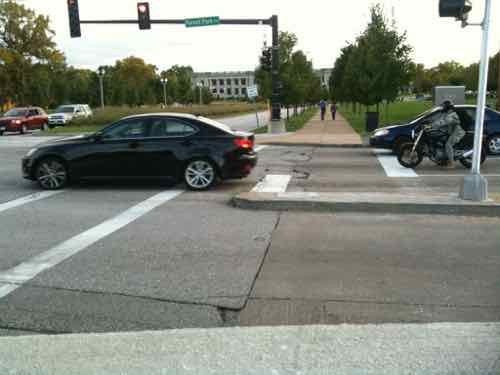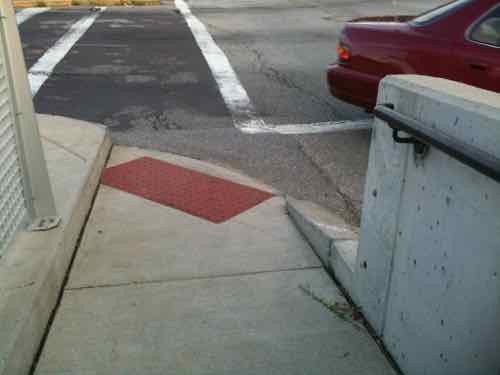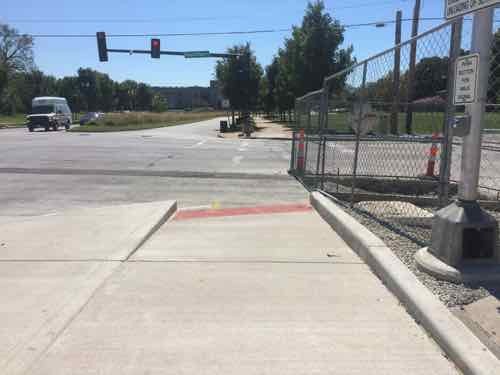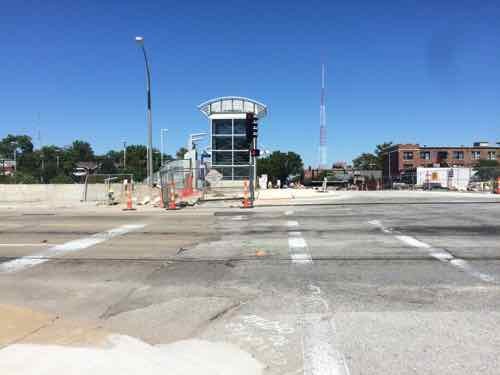Ramps To Cross Forest Park Parkway at DeBaliviere Greatly Improved
I often post about accessibility problems, but today’s post is about a problem that’s finally getting addressed. The reconstruction of the DeBaliviere viaduct/bridge over MetroLink tracks is making great improvements to crossing Forest Park Parkway (map). Tuesday I saw the improvement on the newly-opened West side.




After the East side and the crosswalks are complete I’ll do another post. I’m just so thrilled at the ramp improvement!
Hopefully the pedestrian signal buttons, once activated, will be solely for the visually impaired to get audio signals about when to cross. Other pedestrians shouldn’t need to press a button to get a walk signal.
— Steve Patterson
I’m totally baffled by your last statement. It sounds like you want pedestrians to be accomodated on every cycle (whether they’re present, or not) AND you want the visually impaired to have to locate the buttons and activate them when they want an audible signal to cross?! If we’re doing the former, why not have audible signals all the time, instead of making it more challenging for the visualy impaired? There are no residences within earshot of any of these crosswalks . . .
Pedestrian-friendly cities don’t make people search for and press buttons to get a walk signal.
I’m no expert on signals for those who are visually challenged. I believe the best practice now is a slight beep to locate the button. Once pressed it says “wait to cross (street name)” and then “walk sign is on to cross (street name)”
There are certainly intersections (like this one) where pedestrians should (probably?) get a “walk” signal on every cycle, but there are also plenty of other signalized intersections where pushing the button (to activate the walk signal) will remain a necessity. There is certainly no reason for a traffic signal to cycle endlessly, for vehicles OR pedestrians, if there are none waiting to cross. And unlike vehicles (that can activate signals passively / remotely), there really isn’t an effective way for pedestrians to do the same thing (passively activate the signal), so for those lesser-used crosswalks (of which there are many), some monr effort will always be required!
Sounds like you haven’t noticed that traffic signals in the city don’t have activation strips in the pavement. Our signals are on timers — they cycle through their settings regardless of vehicles or pedestrians.
And when they automatically give vehicles a green light why not automatically give pedestrians a walk signal?
Some are, some aren’t (on fixed-time cycles”). The one at Landsdowne & River Des Peres is on a variable cycle. I agree, if it’s a fixed cycle, pedestrians need to be included / accommodated. But if there are sensors, there’s no reason to provide a pedestrian phase on every cycle.
100% of the intersections I’ve experienced throughout the city are fixed time cycles, many of which I had to press a button to get a walk signal.
Obviously, your experiences and mine are different. The question that remains is whether or not pedestrians should be provided a dedicated walk signal, in every direction, on every cycle (eliminating the need for a pedestrian to push a button)? My response is a definite maybe – it depends on a) the width of the intersection, and b) the amount of traffic, both pedestrian and vehicular. In the older parts of downtown and in many residential areas, where the road width is 40′ or less, yes, providing a consistent walk signal makes sense. On busier arterials and/or streets with wider widths (60’+), no, a consistent walk signal does not make sense, in most cases. One, it takes pedestrians longer to cross a wider street than it takes one or two vehicles, and two, there are usually few(er) pedestrians along busier, wider, more-“suburban”, arterial streets. Providing a dedicated walk signal on every cycle will result in a much longer wait between cycles, increasing the amount of jaywalking and slowing down traffic flow, in general, for no good reason.
Locating and pushing a button, as a pedestrian, is mighty small burden / tradeoff for the safety a dedicated walk cycle provides. I get it, you “want” more priority for pedestrians, I just don’t see where having to push a button is that big of a burden. And the alternative (as in be careful for what you ask for) is the unintended consequence of forcing the city / MODOT / traffic engineers to provide a dedicated walk signal on every cycle where one really isn’t needed – the other alternative is to just remove the signal entirely, leaving pedestrians at the mercy of St. Louis drivers respecting the “sanctity” of marked crosswalks, much less respecting unmarked crosswalks! The city is a big place. What works in one part of town may not be the best answer in other parts. One size does not fit all!
Correct — you don’t see. It’s not a problem for you personally so therefore it shouldn’t be a problem to anyone else.
I think it’s fair to say I’ve experienced for more intersections as a pedestrian in our region than you. I’ve posted numerous times about buttons I can’t reach — too high, too far away, etc. There are many disabled trying to live independent lives that don’t have the dexterity that I have — they’re SOL in many cases.
But you don’t have a problem so we should be quiet….
I NEVER said that the buttons should not be placed properly (within reach), I was just disagreeing with your assertion that every intersection should include a pedestrian phase for every direction on every cycle. Reread what I said – “Locating and pushing a button, as a pedestrian, is mighty small burden / tradeoff for the safety a dedicated walk cycle provides.”
As a driver, I deal with crappy, crowded roads, around the region, every day. If there is enough traffic, pedestrian or vehicular, to justify a dedicated cycle, then yes, do it. But if there’s little (or no) traffic, pedestrian or vehicular, or if it only happens at certain times, then no, having a signal cycling mindlessly, 24/7, especially on a major, multi-lane arterial, makes absolutely no sense! Until a better way is figured out, pedestrians are going to have to continue to live with pushing a button. It’s all about trade-offs. Accommodation means doing what is practical and possible, NOT “solving” problems that can’t really be “solved”.
And, no, I don’t expect you (and to others) to just be quiet. I expect you (and others) to come up with practical, incremental solutions (like making buttons functional and reachable), not throwing out urealistic ideas (like “pedestrians shouldn’t need to press a button to get a walk signal.”) Outside the CBD, pedestrians are a definite minority, so expecting the government to provide equal time on a traffic signal to seve a virtually invisible constituency, while other traffic backs up, makes absolutely no sense. People don’t walk because they have to push a button, people don’t walk because they have better options in a pedestrian-unfriendly suburban environment.
Hopeful for improvements a block south at Lindell. Buttons don’t work, and it takes forever to cross Lindell despite very little traffic.
Yes, it’s awful.
Good to see some progress. I look forward to your write-up of the ped/sidewalk access in the IKEA area… I assume it’ll be forthcoming? I did see some work being done for Sarah, including some safe harbor in the Forest Park Ave median.
I’ll look at both Duncan Ave and IKEA before the store opens on the 30th.